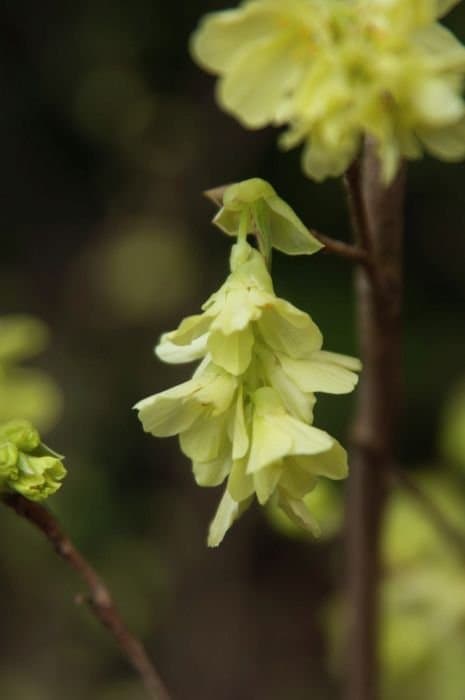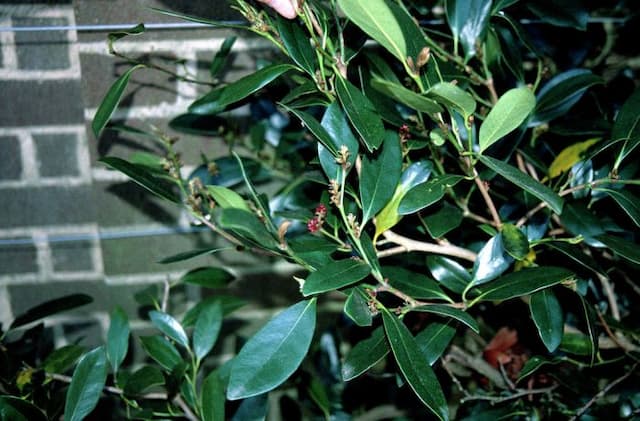Sweetgum Liquidambar styraciflua 'Wisley King'

ABOUT
The sweetgum 'Wisley King' is known for its distinctive star-shaped leaves which boast a deep glossy green color during the growing season. As autumn approaches, these leaves spectacularly transform into a kaleidoscope of hues, including shades of red, purple, and orange, creating a visual feast in the landscape. The foliage is not only remarkable for its color but also adds a textural element due to its unique shape. This cultivar of sweetgum produces a tidy, pyramidal shape that gives structure to gardens and parks. Although the size of the plant is not to be discussed, the overall form exudes an aura of stateliness. The bark on a sweetgum 'Wisley King' has distinct ridges and furrows, giving it an interesting texture that adds to the year-round interest of the tree. In winter, when the leaves have fallen, the silhouette of the plant, with its sturdy branching pattern, contributes an architectural feature to the landscape. For those patient enough to watch for them, the tree offers inconspicuous flowers in the spring. These typically give way to the fruit for which the sweetgum is famous: spiky globular balls that hang from the branches. These "gumballs," as they are sometimes called, persist through winter and are a common sight beneath the trees. The sweetgum 'Wisley King' provides a variety of visual interests throughout the seasons, be it through its leaf color, textural bark, unique fruit, or overall shape, making it a well-regarded choice for many temperate landscapes.
About this plant
 Names
NamesFamily
Altingiaceae.
Synonyms
American Sweetgum, Redgum, Sweetgum, Satin Walnut.
Common names
Liquidambar styraciflua.
 Toxicity
ToxicityTo humans
Sweetgum is not commonly known to be a toxic plant to humans. However, ingestion of any part of the plant is typically not advised as it is not intended for consumption. There could be a risk of choking or intestinal blockage if large pieces are swallowed, particularly with the spiny seed pods. If any part of the sweetgum plant is ingested and adverse symptoms develop, seeking medical advice is recommended.
To pets
Sweetgum is not commonly regarded as a toxic plant to pets. However, as with humans, ingestion of plant parts, especially the spiky seed balls, could pose a risk of choking or gastrointestinal obstruction. While toxicity is not a major concern with Sweetgum, it is still best to prevent pets from ingesting the plant to avoid any potential discomfort or complications. If a pet does ingest parts of the plant and seems unwell, consulting a veterinarian is advisable.
 Characteristics
CharacteristicsLife cycle
Perennials
Foliage type
Deciduous
Color of leaves
Varies
Height
40-60 feet (12-18 meters)
Spread
20-30 feet (6-9 meters)
Plant type
Tree
Hardiness zones
5-9
Native area
Americas
Benefits
 General Benefits
General Benefits- Year-round interest - This species is known for providing visual interest across different seasons through its foliage, flowers, and seed pods.
- Autumn color - The Sweetgum tree is highly prized for its stunning fall colors, often displaying a mix of red, purple, and yellow leaves.
- Erosion control - Its well-developed root system helps to stabilize soil and prevent erosion.
- Habitat for wildlife - Offers food and shelter for birds, squirrels, and other wildlife, as its spiked fruits contain seeds that many species feed on.
- Shade providing - With a large, dense canopy, the Sweetgum tree is excellent for providing shade in gardens, parks, and urban streets.
- Landscape design versatility - This plant can be used as a specimen tree, in group plantings, or as an imposing avenue tree.
- Hardiness - The Sweetgum is known for its adaptability to a wide range of soil types and environmental conditions.
- Longevity - This species tends to have a long lifespan, making it a lasting addition to landscapes.
 Medical Properties
Medical PropertiesThis plant is not used for medical purposes.
 Air-purifying Qualities
Air-purifying QualitiesThis plant is not specifically known for air purifying qualities.
 Other Uses
Other Uses- Sweetgum 'Wisley King' wood is often used in woodworking for fine furniture, interior trim, and cabinetry due to its attractive grain and good workability.
- Harvesting gum from the sweetgum tree for small scale production of chewing gum or as a flavoring agent can be an interesting pursuit, although not commonly practiced.
- Sweetgum tree balls, which are the spiky fruits, are sometimes used in crafts for creating wreaths, ornaments, or as natural mulch in gardens after crumbling.
- Dye production: The tannin-rich bark of the sweetgum 'Wisley King' can serve as a source for natural dyes in homemade fabric dyeing projects.
- Photography prop: Its distinctive star-shaped leaves and spiky fruits can be utilized by photographers as natural props for autumnal scene setting.
- Woodturning: The sweetgum's wood is favored by woodturners for creating bowls, pens, and other turned objects because of its ease of turning and finishing.
- Wildlife habitat: The tree's dense canopy can provide nesting sites and cover for birds and other small wildlife in suburban and rural landscapes.
- Soil stabilization: Planted in rows or groups, sweetgum 'Wisley King' can help prevent soil erosion on slopes due to its extensive root system.
- Educational tool: Due to its unique leaf shape, fruit, and fall color, the sweetgum 'Wisley King' can be used in botany classes for teaching plant identification.
- Seasonal displays: Branches of sweetgum with attached seed balls can be incorporated into holiday décor, particularly in autumn and winter arrangements.
Interesting Facts
 Feng Shui
Feng ShuiThe Sweetgum tree is not used in Feng Shui practice.
 Zodiac Sign Compitability
Zodiac Sign CompitabilityThe Sweetgum tree is not used in astrology practice.
 Plant Symbolism
Plant Symbolism- Change and Transformation: The Sweetgum tree, especially noted for its stunning fall foliage color change, symbolizes the ever-changing nature of life and the ability to adapt and transform through different phases.
- Healing: Traditionally, extracts from the Sweetgum tree have been used for medicinal purposes, representing health, healing, and the medicinal qualities of nature.
- Protection: The spiky gumballs produced by the tree are often associated with protection, as they create a natural barrier around the tree.
- Longevity: The Sweetgum tree is known for its long lifespan and sturdiness, making it a symbol of endurance and the ability to withstand the test of time.
 Water
WaterSweetgum trees, like the 'Wisley King', should be watered deeply at planting and regularly during the first growing season to establish a deep, extensive root system. Once established, they typically need less frequent watering and can usually depend on rain, but during prolonged dry spells or drought, additional watering may be necessary. Water the tree every two to three weeks, providing about 15-20 gallons each time for young trees, increasing the amount as the tree grows. Make sure the water penetrates the soil deeply to encourage deep rooting rather than frequent, shallow watering.
 Light
LightSweetgums, including the 'Wisley King' variety, thrive in full sun to partial shade. They perform best when they receive at least 4-6 hours of direct, unfiltered sunlight each day. An ideal spot is an open area away from the shadows of taller structures or trees where it can receive ample sunlight throughout the day, enhancing its growth and fall color.
 Temperature
TemperatureSweetgum trees, such as the 'Wisley King', can tolerate a wide range of temperatures and are hardy in USDA zones 5-9. They can survive minimum winter temperatures down to about -20 to -10°F and handle summer heat well. However, temperatures ranging from 70 to 90°F are ideal for their growth and development.
 Pruning
PruningPrune the 'Wisley King' sweetgum tree to remove broken or diseased branches, to shape the tree, or to remove any potential hazards. It is best to prune in late winter or early spring before new growth begins. Pruning should typically occur every few years as necessary, focusing on maintaining the tree's natural form and removing any problematic branches.
 Cleaning
CleaningAs needed
 Soil
SoilSweetgum 'Wisley King' thrives in rich, moist, well-draining soil with a slightly acidic to neutral pH of 5.5 to 7.5. A mix of loam, compost, and sand or perlite can provide the necessary conditions for healthy growth, offering nutrients, proper aeration, and moisture retention.
 Repotting
RepottingThe 'Wisley King' sweetgum does not typically require frequent repotting as it is usually grown outdoors. When planted in a large-enough space, repotting or transplanting is only necessary if it outgrows its space or for specific landscaping purposes.
 Humidity & Misting
Humidity & MistingSweetgum 'Wisley King' is adaptable to a wide range of humidity levels but prefers average to high humidity conditions. It is typically grown outdoors where it can tolerate the humidity present in its natural environment.
 Suitable locations
Suitable locationsIndoor
Not ideal for indoor growth; requires large space, full sun.
Outdoor
Plant in full sun, well-draining soil; allow ample space for growth.
Hardiness zone
5-9 USDA
 Life cycle
Life cycleSweetgum 'Wisley King' begins its life cycle with germination, which occurs when its seeds, typically dispersed by wind or wildlife, find suitable moist and well-drained soil in full sun to partial shade. After germination, it enters a period of rapid vegetative growth, producing a strong central leader and symmetrical branches that establish its characteristic pyramidal shape. As the tree matures, it develops star-shaped leaves that change from green to spectacular shades of red, orange, and purple in the autumn. The reproductive stage commences with the tree producing inconspicuous yellow-green flowers that are usually wind-pollinated. Following pollination, the flowers develop into distinctive spiky seed balls that persist into winter and gradually release seeds. After many decades, the sweetgum 'Wisley King' will reach its senescence stage, where growth slows, and it may become more susceptible to environmental stress, pests, and diseases, eventually leading to its decline and death.
 Propogation
PropogationPropogation time
Spring-Early Summer
The American Sweetgum, specifically the 'Wisley King' variety, is typically propagated in late winter to early spring before new growth begins. The most popular method of propagation for American Sweetgum trees is through semi-hardwood cuttings. This technique involves taking 4 to 6 inch (10 to 15 cm) cuttings from the current year's growth, ensuring that each cutting has several leaf nodes. The bottom cut should be made just below a leaf node, and the leaves on the lower half of the cutting should be removed. To encourage rooting, dipping the cut end in a rooting hormone can be beneficial before placing the cutting in a well-draining rooting medium such as a mix of peat and perlite. Maintaining a high humidity environment and keeping the cuttings out of direct sunlight helps prevent moisture loss until roots develop, which can take several weeks.









